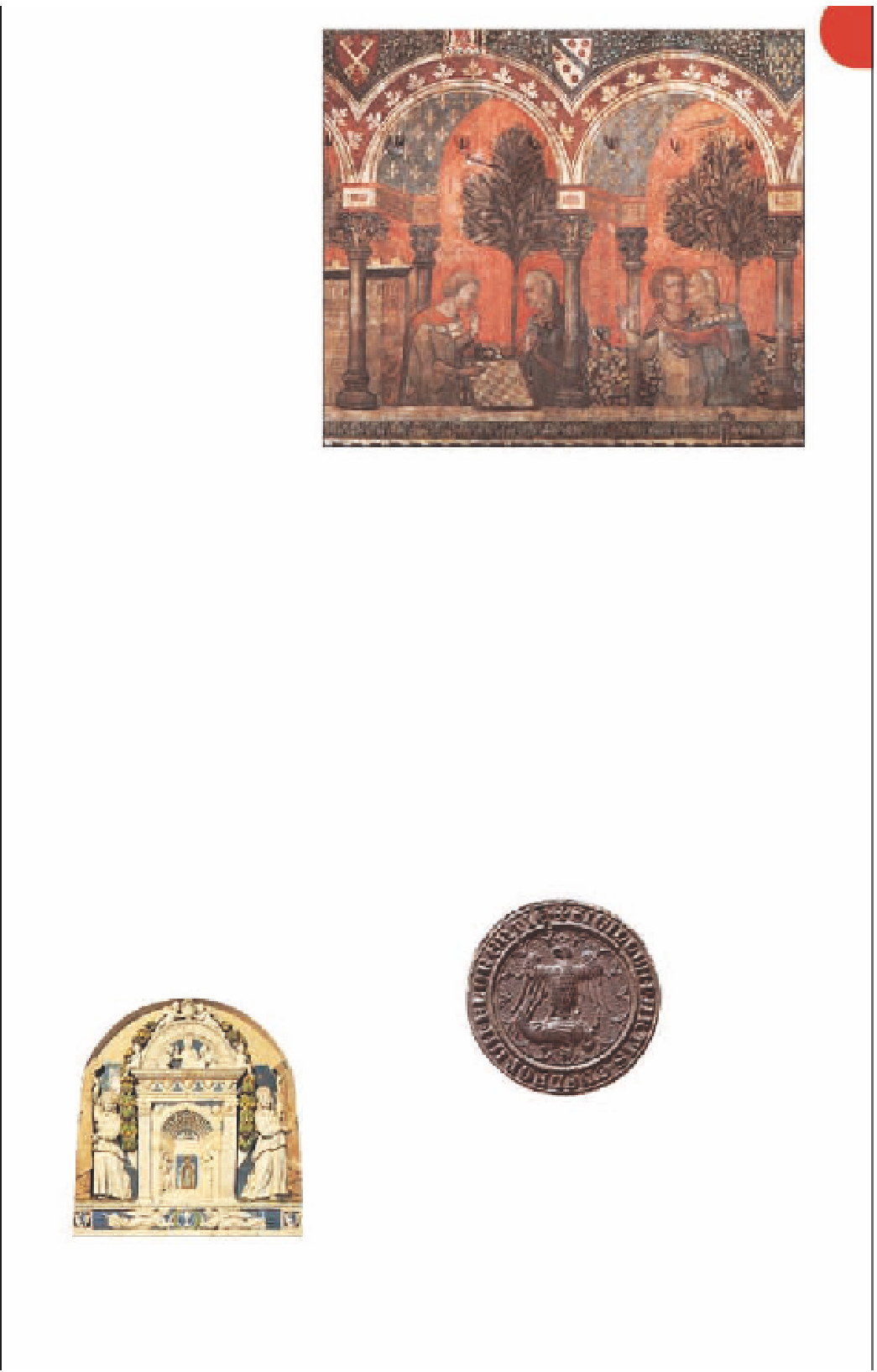Travel Reference
In-Depth Information
Honorius III in the Piazza della
Signoria. Sassetti, who was
general manager of the Medici
bank, is shown with his son,
Teodoro, and with Lorenzo de'
Medici to his right, along with
Antonio Pucci. Lorenzo's sons
are climbing up steps with their
tutors, led by the Humanist
scholar Agnolo Poliziano, or
Politian. The altar painting,
The
Adoration of the Shepherds
(1485), is also by Ghirlandaio;
he is the first, dark-haired
shepherd. The black sarcophagi
of Sassetti and his wife are by
Giuliano da Sangallo.
Santi Apostoli
8
Piazza del Limbo.
Map
3 C1 (5 C4).
Tel
055 29 06 42.
Fresco in a bedroom in the Palazzo Davanzati
#
10am-noon,
Palazzo Davanzati
0
Via Porta Rossa 13.
Map
3 C1 (5 C3).
Tel
055 238 86 10.
4-7pm daily.
^
The restored Salone Mador-
nale, where large gatherings
would have been held, and
the Sala dei Pappagalli (Parrots
Room), with its frescoes and
rich tapestries, are impressive.
Restoration in two rooms
dedicated to lace is ongoing.
The little church of the Holy
Apostles is, along with the
Baptistry, among the oldest
surviving churches in
Florence. Florentines like to
think that the church was
founded in 800 AD by the first
Holy Roman Emperor, Charle-
magne, but it more likely
dates to 1059-1100. The
church has a simple Roman-
esque façade and the
basilican plan typical of early
Christian churches, but with
16th-century side aisles.
Santi Apostoli fronts Piazza
del Limbo, so called because
there was a cemetery here for
infants who died before they
were baptized. Hence, accord-
ing to medieval theology, their
souls dwelt in limbo - halfway
between heaven and hell.
8:15am-
1:50pm daily; second and third floors
closed.
#
1st, 3rd & 5th Mon and
2nd & 4th Sun of the month; 1 Jan,
1 May, 25 Dec.
¢
Also known as the Museo
dell'Antica Casa Fiorentina,
the Palazzo Davanzati is
preserved as a typical house
of wealthy Florentines of the
14th century. The entrance
courtyard was designed to
trap unwanted visitors; holes
in the vaulted ceiling were
used for dropping missiles. In
the more peaceful inner
courtyard, a staircase
links all the floors.
In one corner is a
well and a pulley
system so buck-
ets of water
could be raised
to each floor -
this ingenious
mechanism was
quite a luxury
since most house-
holds had to fetch
all their water from a public
fountain.
The main living room on
the first floor looks plain,
but hooks beneath the
ceiling show that the walls
would have been hung
with tapestries. Many rooms
have bathrooms attached,
and are decorated with
frescoes of scenes from
a French romance.
Palazzo di Parte
Guelfa
q
Piazza di Parte Guelfa.
Map
3 C1
(6 D3).
¢
to the public.
This characterful building
served as the headquarters
of the Guelph party and the
residence of its captains from
around 1266, after the
Guelphs began to
emerge as the
stronger of the
two medieval
factions strug-
gling for control
over Florence.
In the complex
politics of the
period, the Guelphs
supported the
Pope and the
Ghibellines took the side of
the Holy Roman Emperor in
the dispute over who should
rule northern Italy
(see p46)
.
The lower part of the
building dates to the 13th
century, but the upper part was
added by Brunelleschi in 1431.
There are
stemmae
(coats-of-
arms) under the crenellations.
The elegant open staircase,
added in 1589, is by Vasari.
Emblem of the Guelphs
Della Robbia glazed terracotta
tabernacle in Santi Apostoli
Ponte Vecchio
9
See pp106-7.






































